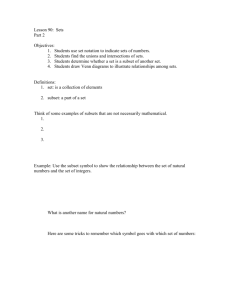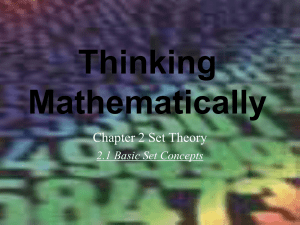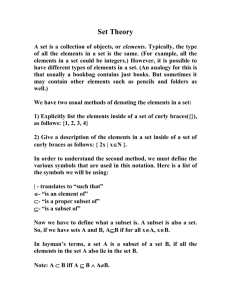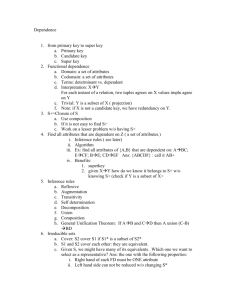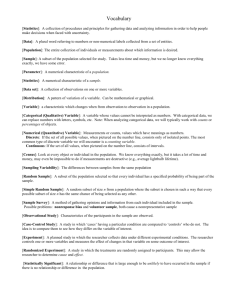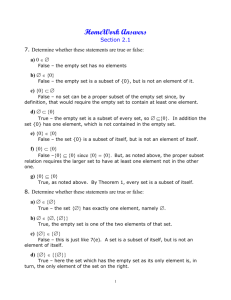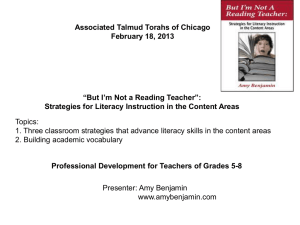7.1 Sets - GEOCITIES.ws
advertisement
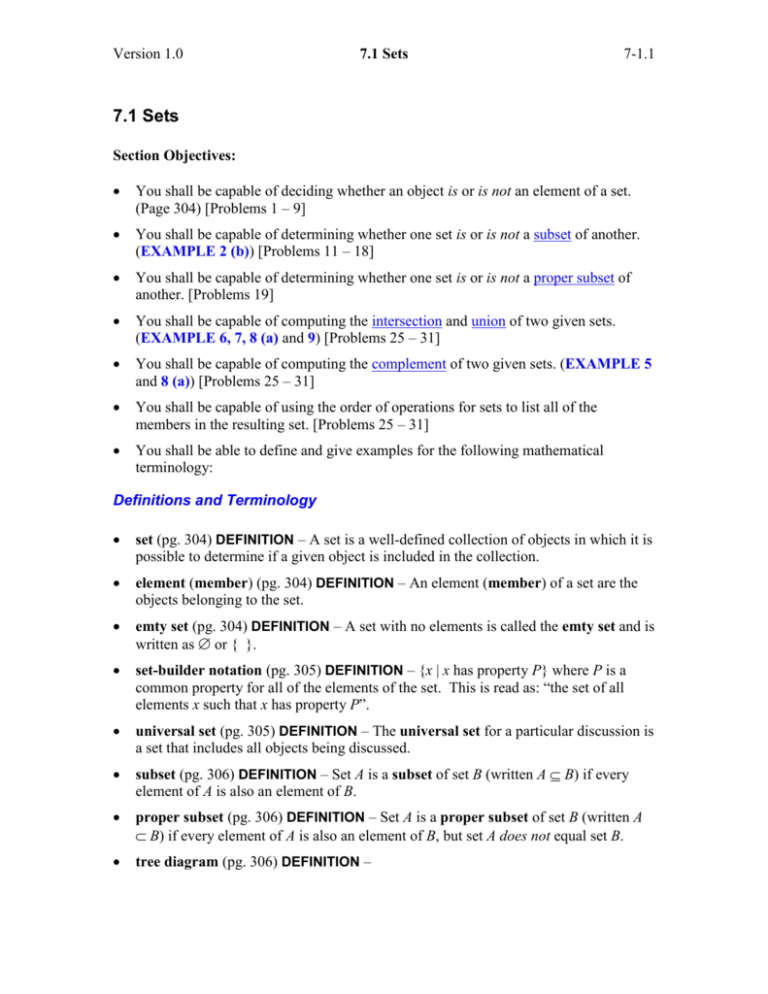
Version 1.0
7.1 Sets
7-1.1
7.1 Sets
Section Objectives:
You shall be capable of deciding whether an object is or is not an element of a set.
(Page 304) [Problems 1 – 9]
You shall be capable of determining whether one set is or is not a subset of another.
(EXAMPLE 2 (b)) [Problems 11 – 18]
You shall be capable of determining whether one set is or is not a proper subset of
another. [Problems 19]
You shall be capable of computing the intersection and union of two given sets.
(EXAMPLE 6, 7, 8 (a) and 9) [Problems 25 – 31]
You shall be capable of computing the complement of two given sets. (EXAMPLE 5
and 8 (a)) [Problems 25 – 31]
You shall be capable of using the order of operations for sets to list all of the
members in the resulting set. [Problems 25 – 31]
You shall be able to define and give examples for the following mathematical
terminology:
Definitions and Terminology
set (pg. 304) DEFINITION – A set is a well-defined collection of objects in which it is
possible to determine if a given object is included in the collection.
element (member) (pg. 304) DEFINITION – An element (member) of a set are the
objects belonging to the set.
emty set (pg. 304) DEFINITION – A set with no elements is called the emty set and is
written as or { }.
set-builder notation (pg. 305) DEFINITION – {x | x has property P} where P is a
common property for all of the elements of the set. This is read as: “the set of all
elements x such that x has property P”.
universal set (pg. 305) DEFINITION – The universal set for a particular discussion is
a set that includes all objects being discussed.
subset (pg. 306) DEFINITION – Set A is a subset of set B (written A B) if every
element of A is also an element of B.
proper subset (pg. 306) DEFINITION – Set A is a proper subset of set B (written A
B) if every element of A is also an element of B, but set A does not equal set B.
tree diagram (pg. 306) DEFINITION –
Version 1.0
7.1 Sets
7-1.2
set operations (pg. 304) DEFINITION – Set operations are ways to form new sets
from one or two given sets. Set operations include the complement , intersection and
union operations.
Venn Diagram (pg. 307) DEFINITION –
complement of a set (pg. 307, 308) DEFINITION – Let A be any set, with U
representing the universal set. Then the complement of set A are all elements in the
universal set but not elements of set A. A ={x | x A and x U}.
intersection of two sets (pg. 308) DEFINITION – Let A and B be any two sets, with U
representing the universal set. Then the intersection of sets A and B are all elements
in the universal set that are elements of both sets A and B.
A B ={x | x A and x B}.
disjoint sets (pg. 304) DEFINITION – For any two sets A and B, if A and B are
disjoint sets, then the intersection of sets A and B is empty. A B = .
union of two sets (pg. 304) DEFINITION – Let A and B be any two sets, with U
representing the universal set. Then the union of sets A and B are all elements in the
universal set that are elements of set A, elements of set B, or both sets A and B.
A B ={x | x A or x B}.
Mathematical Notation or Symbols
Symbol Section
{}
7.1
A, B, ...
7.1
7.1
7.1
7.1
…
7.1
{1, 2}
7.1
{x | x has property
P}
{}
7.1
7.1
7.1
7.1
7.1
U
7.1
7.1
A
7.1
7.1
Meaning
Set braces, meaning "the set."
Sets are named with capital letters of the alphabet.
Such that
Is an element (or member) of
Is not an element (or member) of
Ellipsis, means that the list goes on in the same pattern
List (or roster) notation
7.1
Set-builder notation. This is read as “the set of all
elements x such that x has property P”
The empty, or null, set
The empty, or null, set
Equals. Refer to equality of sets.
Is a subset of
Is a proper subset of
The universal set
The complement of set A.
The intersection of two sets.
The union of two sets.
Version 1.0
7.1 Sets
7-1.3
Concepts, Facts, Theorems
The number of elements in the empty set is zero. (n() = 0).
The empty set is a subset of itself. ( ).
The empty set is not a proper subset of itself. ( ).
The empty set is a subset of every set, including itself (For all sets A, A).
The empty set is a proper subset of every set, except itself (If A is any set A , then
A).
Every set is a subset of itself. (For all sets A, A A).
If A B, and B A, then A = B.
A set of n elements has 2n subsets.
The empty set is a subset of every set.
The empty set is not a proper subset of every set. However, the empty set is a proper
subset of every nonempty set.
The empty set contains no elements, hence the cardinality of the empty set is zero.
The statement is FALSE. The statement is TRUE.
Common student mistakes and misunderstandings
Students confuse the symbols and . They can not remember which symbol goes
with a subset and proper subset. One way to remember is to associate with (less
than or equal to), and with <. First, remember that only one of the two symbols
and allows for equality to occur between the two given sets, namely the symbol
with the "equals to," like in the symbol (less than or equal to). Equality only occurs
when A = B, which is part of the definition for a subset, but not part of the definition
for a proper subset.
Students confuse the symbols and . Remember that the symbol means “is an
element of” and the same symbol with a line through it, , negates the phrase “is an
element of”. Hence, the symbol means “is not an element of”. This concept of a
vertical line holds true for other mathematical symbols, such as = (equals) and (not
equals).
Procedure to Determine the Complement of a Set, A
1. Write down the universal set U.
2. Cross-out every element in set A. Whatever remains is the complement of set A.
Procedure to Determine the Intersection of two Sets, A B
1. Write down every element in set A.
2. For each element in Step 1, check to see if it is in set B. If it is not in set B, then cross
it out. Whatever remains is the complement of set A.
Version 1.0
7.1 Sets
7-1.4
Procedure to Determine the Union of two Sets, A B
1. Write down every element in set A, followed by every element in set B.
2. Cross-out every element in the list generated from Step 1 that is repeated. Whatever
remains is the union of sets A and B.
Order of Operations for Sets
The Order of Operations Agreement
Step 1 Perform all set complements, unless they appear outside parentheses.
Step 2 Perform operations inside grouping symbols, like parentheses ( ) and brackets.
If a grouping symbol has a set complement () on the outside, apply the
complement operation to the final resultant set inside the grouping symbol.
Step 3 Do all intersections () and unions () as they occur from left to right, using the
concept of Dominance of Set Operations (see below). The order should follow
from least to most dominant.
Step 4 Your final answer occurs for whatever elements remain after performing the steps
above.
The concept of Order of Operations for Sets works in a way similar to PEMDAS
does in algebra
Parentheses – Do these first working from the inner most set of parentheses to the
outer most, using the order given in the Dominance of Connectives.
When no more Parentheses remain, use the Dominance of Set Operations to
evaluate the final result, which will occur by the most dominant connective. Work
the connectives and in the order that they appear, from LEFT to RIGHT, like
you read a book.
Dominance of Set Operations
Least dominant
1. Complement. A
Most dominant
2. Intersection, ; Union,
Evaluate first, when applied to
one set.
Evaluate second


